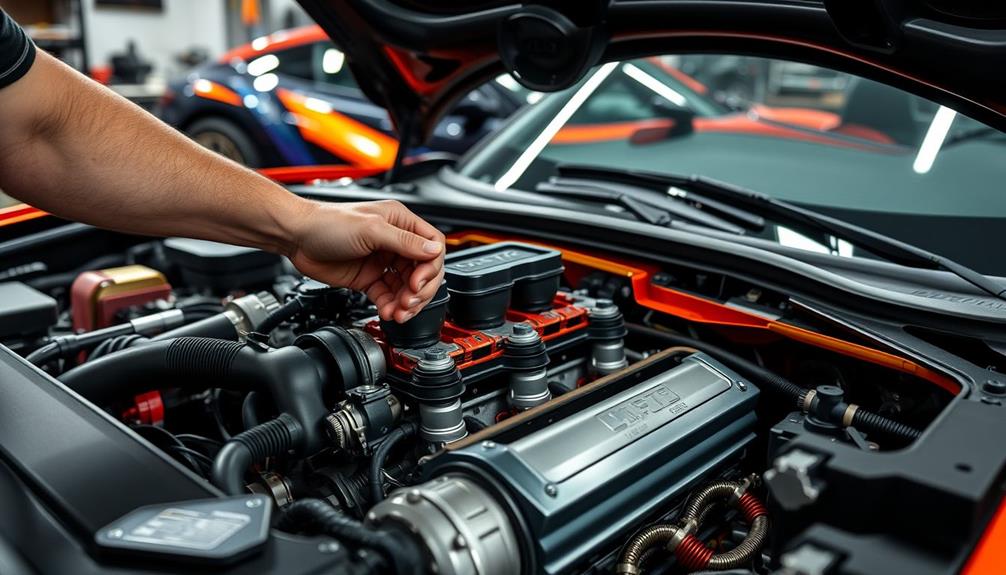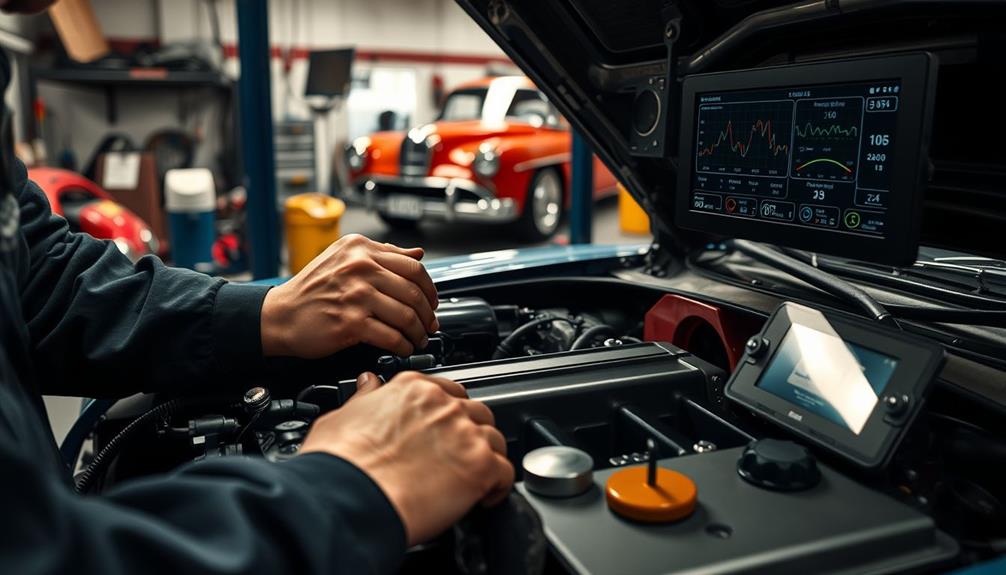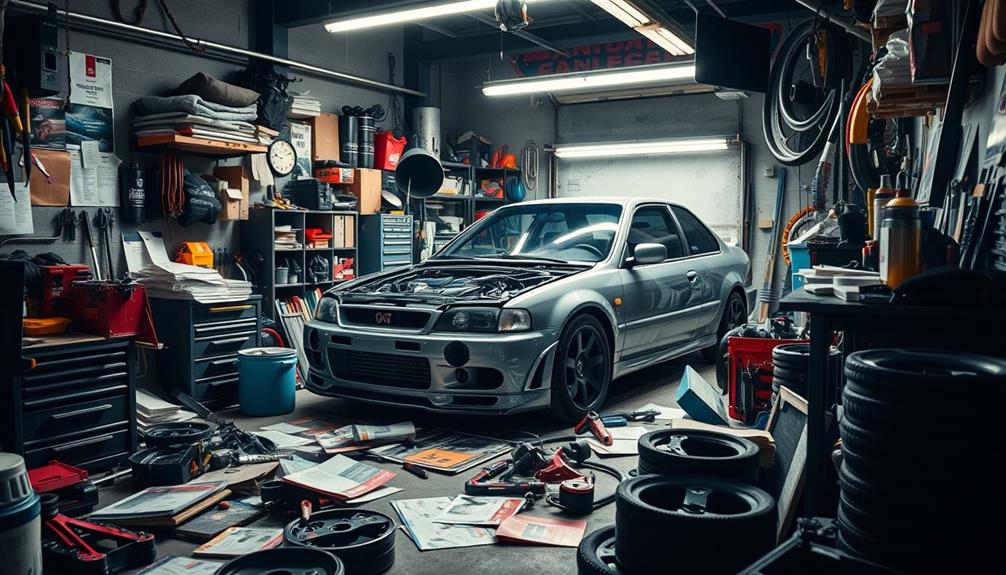To upgrade your car’s exhaust system for better sound and power, start by ensuring the parts fit your vehicle’s year, model, and engine type. Choose performance headers, high-flow catalytic converters, and mufflers to improve flow and sound. Opt for durable materials like stainless steel, and consider customizing tips for style. Don’t forget to check local laws and emissions rules. With proper selection and tuning, you’ll see noticeable gains—keep going to learn more about maximizing your upgrade.
Key Takeaways
- Choose performance headers and high-flow catalytic converters to improve exhaust flow and increase power.
- Opt for larger diameter pipes and mandrel bends to reduce backpressure and enhance sound output.
- Select mufflers and tips that produce your desired sound profile while maintaining street legality.
- Ensure all components meet EPA or CARB standards for emissions and noise compliance.
- Have a professional tune the ECU to maximize gains in sound, efficiency, and engine performance.
Assessing Your Vehicle’s Compatibility and Goals
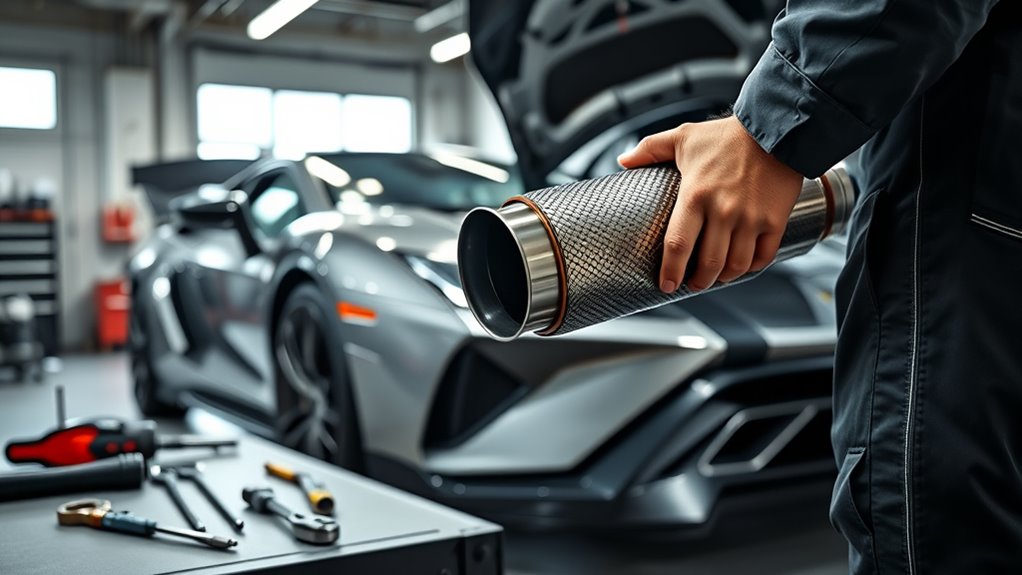
Before upgrading your car’s exhaust system, it’s essential to assess your vehicle’s compatibility and set clear goals. You need to verify the new exhaust is designed specifically for your model to maximize performance. Check your engine type—gasoline, diesel, or hybrid—as each has unique requirements. Compatibility & Fit Review any existing modifications that could affect the upgrade, and understand your original exhaust system’s configuration for a seamless fit. Confirm your vehicle’s year and generation to match the right parts. Additionally, familiarize yourself with local regulations regarding emissions, noise levels, and inspections to stay compliant. Clarifying your goals—whether you want more power, a deeper sound, reduced weight, or better fuel efficiency—helps guide your choices and ensures a successful upgrade. Considering the exhaust system technology can also influence your selection, as different designs offer varying performance benefits. Being aware of the vehicle’s sound profile can help you choose an exhaust that aligns with your desired acoustic results.
Choosing the Right Exhaust Components for Performance
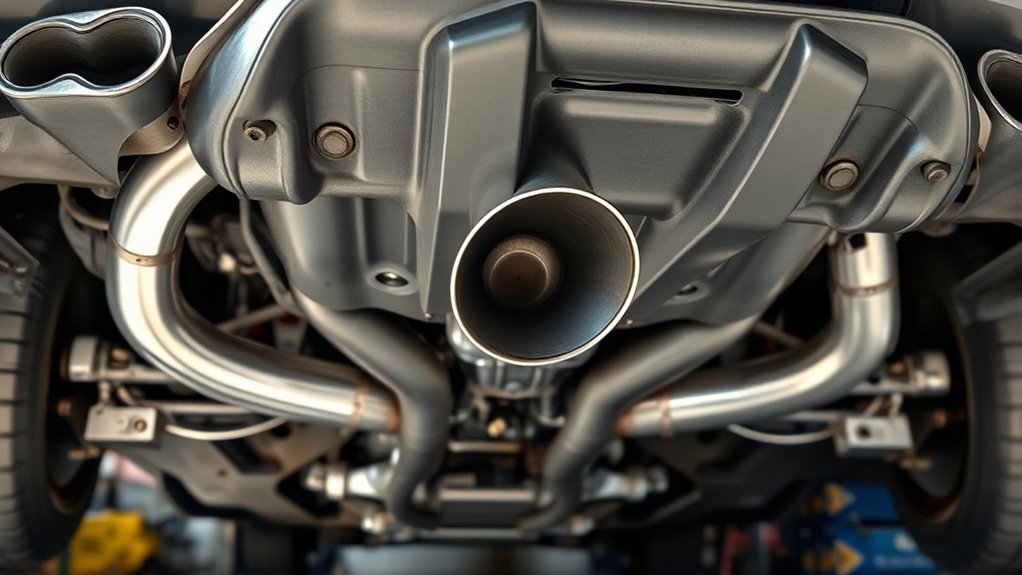
Selecting the right exhaust components is essential for maximizing your vehicle’s performance gains. Start with performance headers, which can significantly boost horsepower and torque by improving exhaust flow. Opt for stainless steel or ceramic-coated headers for durability and ideal performance. Manifolds are designed to collect exhaust gases from each cylinder and funnel them into a common outlet, so choosing high-quality manifolds ensures better flow and efficiency. Choose design options with larger diameters and less restrictive pathways to enhance flow further. Guarantee compatibility with your existing exhaust system to prevent fitment issues. For mid-pipes, high-performance options like X-pipes or H-pipes reduce backpressure and tailor sound and torque characteristics. Upgrading to high-flow catalytic converters can improve exhaust flow while maintaining emissions standards. When upgrading the catalytic converter, select high-flow designs that balance emissions compliance and flow efficiency. Proper selection and compatibility are key to revealing your vehicle’s full performance potential, especially when considering ECU remapping to optimize overall tune and power delivery. Finally, pick mufflers that are less restrictive, lightweight, and suited to your desired sound profile.
Selecting Sound and Aesthetic Customizations
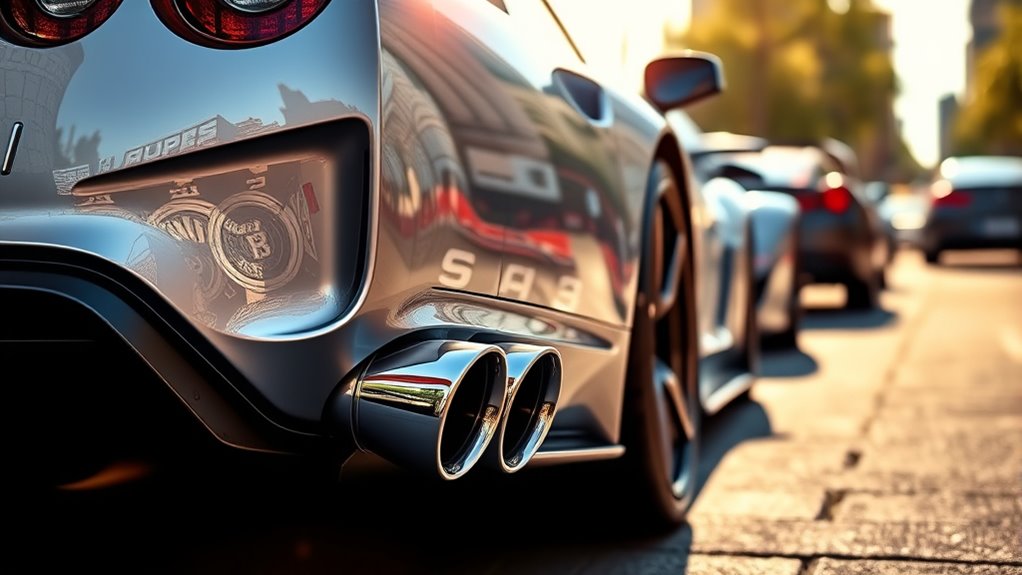
After choosing the right performance components, customizing your exhaust system’s sound and appearance lets you personalize your vehicle’s personality. You can select exhaust tips in various shapes, finishes, and materials like stainless steel, carbon fiber, or chrome, matching your style. These tips are easy to install and subtly enhance your exhaust sound. To help you decide, consider this table:
| Style | Material | Effect |
|---|---|---|
| Round | Chrome | Classic look, minor sound change |
| Square | Carbon fiber | Modern aesthetic, lightweight |
| Slash-cut | Stainless steel | Sporty appearance, slight sound boost |
Choose based on your aesthetic preference and desired sound. Remember, legal considerations are key—ensure your modifications comply with local noise laws. Additionally, exhaust sound can vary significantly depending on your choice, so listen to sound clips or test drives if possible before making a final decision. Incorporating refrigeration cycle principles can help optimize your system’s performance if considering further modifications.
Understanding Material Options and Design Styles

Understanding the options for exhaust materials and design styles is essential when customizing your vehicle’s exhaust system. You can choose mild steel, which is affordable and easy to shape but prone to rust without coatings. Stainless steel offers superior corrosion resistance and durability, making it ideal for high-temperature parts like headers. Stainless steel is also more resistant to extreme temperatures, ensuring longevity even under heavy use. Aluminized steel provides a good balance, with an aluminum coating that resists rust better than mild steel. For high-performance needs, nickel alloys and titanium deliver strength and lightweight benefits, respectively. Additionally, selecting the right exhaust design can significantly influence your vehicle’s sound and efficiency, allowing you to customize your driving experience further. Considering material properties can help you choose the best options for your specific driving conditions and goals. When it comes to design styles, options range from cat-back systems that improve sound and performance, to axle-back and turbo-back setups for targeted upgrades. Headers and muffler designs also influence exhaust flow, sound, and efficiency, helping you tailor your system to your goals.
Planning for Legal Compliance and Emissions Regulations
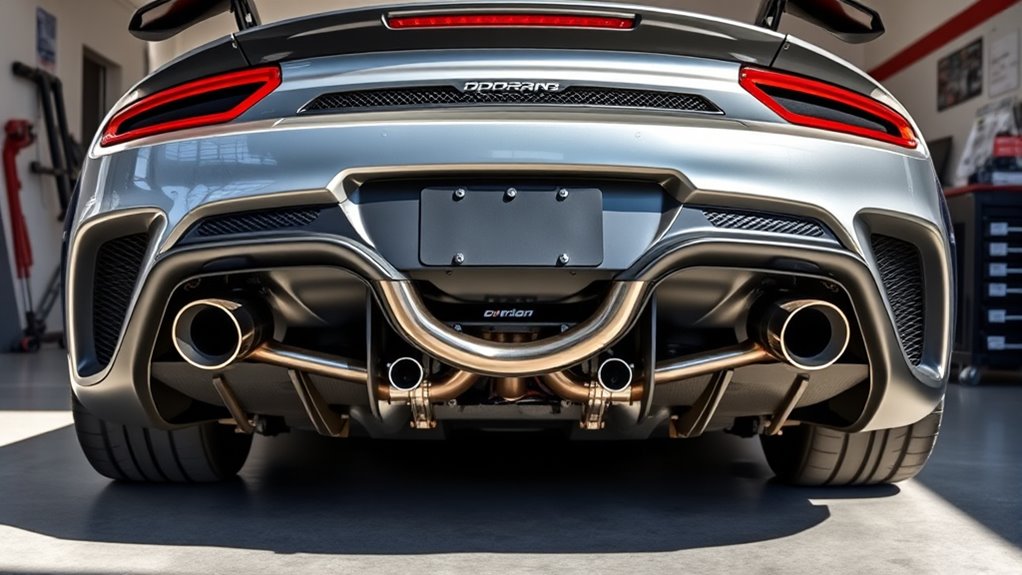
When customizing your exhaust system, it’s important to take into account legal compliance and emissions regulations from the start. In the U.S., agencies like the EPA and CARB set strict standards that aftermarket parts must meet. Failing to adhere to can lead to fines, failed inspections, or even vehicle impoundment.
Your exhaust system should maintain or improve emissions controls, such as catalytic converters and oxygen sensors, to stay legal. Some states require certification or proof of compliance, especially for modifications.
During emissions testing, aftermarket exhausts mustn’t interfere with diagnostics or exceed emission limits for pollutants like NOx, CO, HC, or PM. Designing your system with these regulations in mind ensures your upgrades are both effective and street-legal.
Considering Professional Installation and Tuning

Choosing a professional for your exhaust system upgrade guarantees the job is done correctly and safely. Expert technicians know which components suit your vehicle and can handle the installation with precision, thanks to their specialized tools. They can inspect your current exhaust for issues before upgrading, preventing future problems. Service Inclusions Many shops also offer demonstration and white glove treatment post-installation, ensuring your vehicle is thoroughly checked and presented in top condition. Plus, many offer warranties and guarantees, giving you peace of mind. During installation, they’ll align each part carefully to avoid leaks and ensure proper fitment, tightening everything securely. Afterward, they perform a post-installation check to confirm everything runs smoothly. This professional approach is especially important considering the growing acceptance of digital assets in mainstream finance, as it can influence the reliability and trust in vehicle modifications. Proper quality assurance during the upgrade process can significantly impact your vehicle’s performance and longevity. Tuning is equally important; professionals can perform dyno tests, adjust engine mappings, and optimize airflow to maximize performance and sound. With expert help, your upgrade delivers improved power, sound, and efficiency safely and effectively.
Maintaining Your Upgraded Exhaust System
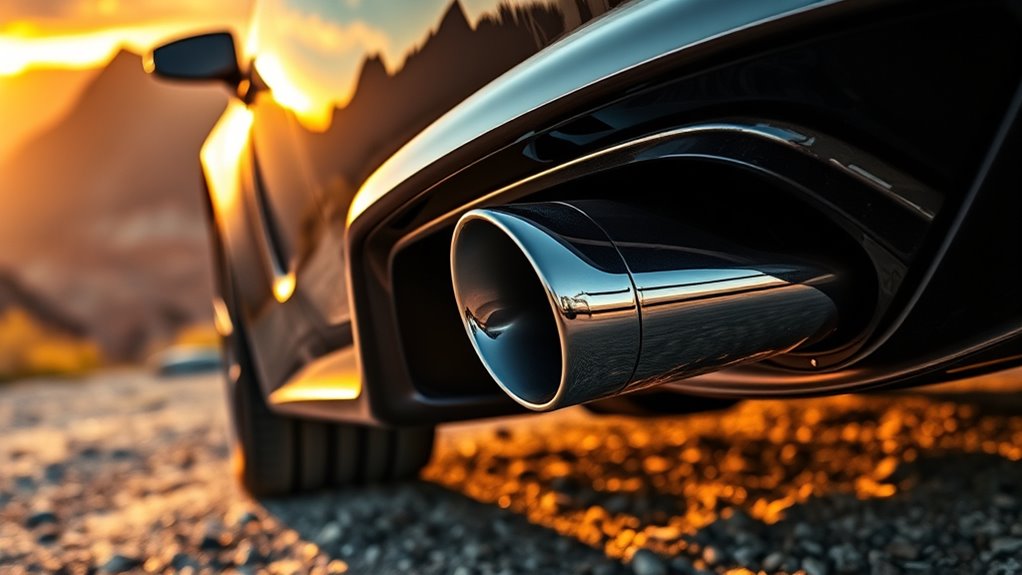
Maintaining your upgraded exhaust system is essential to guarantee it continues delivering peak performance and longevity. Start by inspecting for leaks around seams and connections, looking for rust or soot buildup. Check for rust and corrosion regularly, addressing any issues before they worsen. A well-maintained system can prevent emissions violations and help you pass inspections. Look for dents, cracks, or loose parts that could impair function. Clean the exterior with mild soap and water to prevent dirt buildup, and periodically drive at higher speeds to help clear internal deposits. Use specialized exhaust cleaners for internal cleaning and listen for unusual sounds that might indicate problems. Conduct visual inspections frequently, and consider professional checkups if you notice persistent issues. Replacing worn or damaged components promptly ensures your system remains efficient, sounds great, and lasts longer.
Evaluating Cost, Benefits, and Long-Term Savings

Evaluating the costs, benefits, and long-term savings of upgrading your car’s exhaust system helps you make informed decisions that match your goals and budget. Upfront, partial upgrades cost $200-$800, while full systems range from $600-$2,500+, with custom builds exceeding $3,000. Replacing catalytic converters adds $200-$2,200+, depending on emissions laws. Benefits include improved engine breathing, better fuel efficiency, and weight reduction, which boost power and save money over time. Sound modifications can make your ride more aggressive, but may affect legality. Long-term, stainless steel systems last over a decade, saving you replacement costs. Consider this table to see how costs and gains align:
| Cost Factor | Benefit |
|---|---|
| Upfront expense | Performance enhancement |
| Maintenance and durability | Long-term savings |
| Installation costs | Better driving experience |
| Region-specific laws | Compliance and peace of mind |
Improving Performance With Additional Modifications

Enhancing your car’s performance often requires more than just upgrading the exhaust system; combining it with additional modifications can open significant power gains. Upgrading to a cat-back or turbo-back system improves airflow, especially when paired with high-flow catalytic converters or de-cat pipes. Research shows increasing piping diameter and using mandrel bends further reduce backpressure, boosting engine efficiency. ECU tuning is essential to optimize air-fuel ratios and ignition timing, unlocking the full potential of your upgrades. Supporting airflow enhancements like cold air intakes and larger throttle bodies help balance intake and exhaust flow, resulting in smoother power delivery. If you have forced induction, upgrading the exhaust enables better turbo spool and reduces temperatures. Together, these modifications maximize horsepower, responsiveness, and overall engine performance for a more exhilarating drive.
Enhancing Your Vehicle’s Appearance and Personal Style
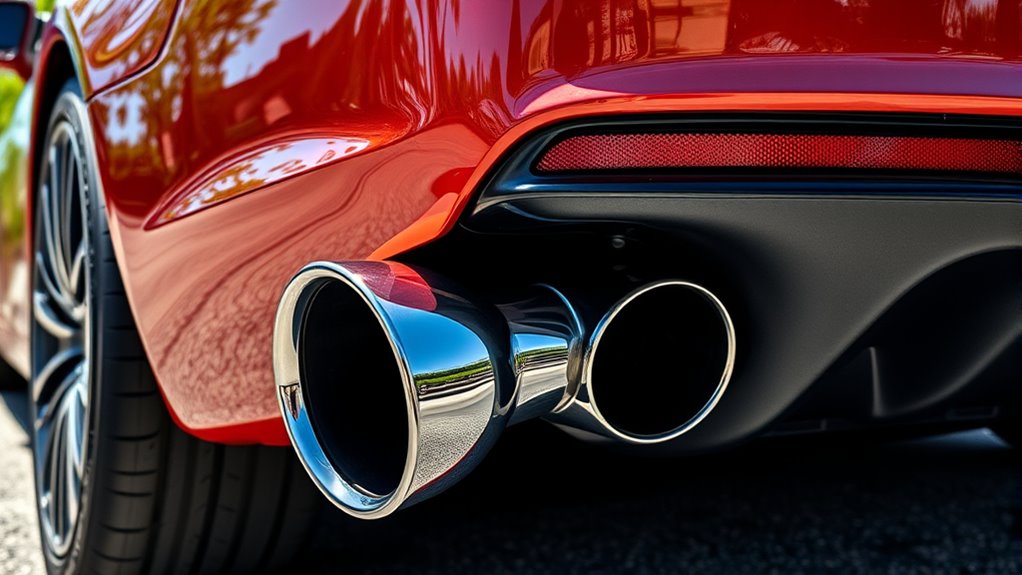
Customizing your exhaust system is a great way to enhance your vehicle’s appearance and express your personal style. You can choose heat-resistant coatings like matte or gloss black, or high-temperature colors, to add visual flair while protecting against corrosion. Selecting the right coatings can also help maintain the appearance of your exhaust over time, especially in harsh conditions. Chrome plating offers a shiny, classic look that’s durable, while ceramic coatings improve heat insulation and provide a sleek finish. Colored titanium finishes give a premium, unique visual with extra strength, and stainless steel provides a polished, long-lasting shine. Selecting different tips—dual, slash-cut, round, or rectangular—further refines your look. Tailoring tailpipe placement, bumper cutouts, and mounting options helps create a seamless, integrated appearance. Finish with custom logos or matching colors to your car’s paint for a personalized touch that highlights your style.
Frequently Asked Questions
How Does an Upgraded Exhaust Affect My Vehicle’S Warranty?
An upgraded exhaust can impact your vehicle’s warranty, but it depends on the modification type. Cat-back systems usually don’t void warranties, while high-performance or full systems might, especially if they involve altering emissions components.
To protect your warranty, use OEM parts, keep detailed records of installations, and consult your warranty terms. Staying informed about legal protections, like the Magnuson-Moss Act, can also help you defend your rights if issues arise.
Are There Specific Exhaust Systems Recommended for My Vehicle Make and Model?
You should look for exhaust systems specifically designed for your vehicle make and model. Check compatibility to guarantee perfect fit and peak performance.
Consider reputable brands known for durability and quality. Decide between cat-back or axle-back systems based on your performance goals and budget.
Think about sound preferences and materials like stainless steel for longevity.
Proper installation guarantees the best results, so choose experienced professionals for the job.
What Are the Best Practices for Maintaining My Upgraded Exhaust System?
To keep your upgraded exhaust system in top shape, you should inspect it regularly for rust, cracks, or leaks, and clean it gently with mild soap and a soft brush.
Address issues promptly, replacing damaged parts with durable materials.
Schedule professional inspections every year, especially after upgrades, and monitor engine performance.
Proper maintenance guarantees your system stays efficient, sounds great, and meets emissions standards while maximizing power and fuel economy.
Can I Upgrade My Exhaust System Without Affecting Emissions Compliance?
You want to upgrade your exhaust system without messing up emissions compliance, and that’s possible if you choose CARB-certified parts with valid EO numbers.
Make sure the parts retain your OEM catalytic converters, keep O2 sensors working properly, and follow installation instructions.
Avoid defeat devices or unapproved modifications, as federal and state laws strictly prohibit them.
Always verify EO labels and check local regulations to stay compliant.
How Long Does a Typical Exhaust Upgrade Installation Take?
You’re wondering how long installing an exhaust upgrade usually takes. If you’re installing an axleback system, it can take as little as 10 minutes if there are no rusted bolts.
For a full catback system, expect about an hour at a professional shop. However, rusted bolts or vehicle complexity can extend this time.
DIY installs may take longer due to experience and tools, while professional shops typically work faster.
Conclusion
Upgrading your exhaust system not only boosts your car’s sound and power but also enhances its style. Did you know that a well-installed exhaust can improve horsepower by up to 10%? That’s like giving your vehicle a serious performance boost without breaking the bank. By choosing the right components and staying compliant with regulations, you’ll enjoy a more dynamic drive and a personalized look that turns heads everywhere you go. Get ready to feel the difference every time you hit the road.



